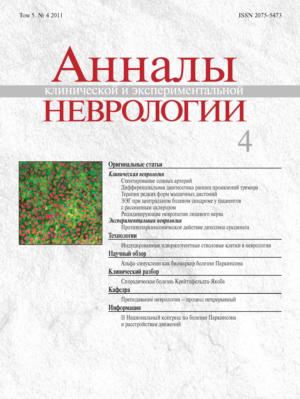Комплексный подход к терапии редких форм мышечных дистоний
- Авторы: Лихачев С.A.1, Чернуха Т.Н.1, Навоша С.A.2, Мельник В.Ф.3, Борисенко A.В.1, Забродец Г.В.1, Черненко Н.И.1, Зобнина Г.В.1
-
Учреждения:
- Республиканский научно-практический центр неврологии и нейрохирургии Министерства здравоохранения Республики Беларусь
- Кафедра челюстно-лицевой хирургии Белорусского государственного медицинского университета
- Отделение оториноларингологии Республиканского госпиталя Министерства внутренних дел Республики Беларусь
- Выпуск: Том 5, № 4 (2011)
- Страницы: 17-20
- Раздел: Оригинальные статьи
- Дата подачи: 03.02.2017
- Дата публикации: 13.02.2017
- URL: https://annaly-nevrologii.com/journal/pathID/article/view/293
- DOI: https://doi.org/10.17816/psaic293
- ID: 293
Цитировать
Полный текст
Аннотация
Проанализирована клиническая картина болезни у пациентов с редкими формами мышечной дистонии, проживающих в Белоруссии. Обсуждены клинические варианты этих заболеваний и предложены комплексные подходы к их терапии. Согласно многолетнему опыту авторов оптимальная терапия писчего спазма, оромандибулярной дистонии, камптокормии, сегментарных и мультифокальных форм мышечных дистоний должна включать использование медикаментозной терапии, инъекций ботулотоксина типа А, физиотерапевтического лечения.
Ключевые слова
Об авторах
С. A. Лихачев
Республиканский научно-практический центр неврологии и нейрохирургии Министерства здравоохранения Республики Беларусь
Email: tatyana_ch@fromru.com
Белоруссия, Минск
Т. Н. Чернуха
Республиканский научно-практический центр неврологии и нейрохирургии Министерства здравоохранения Республики Беларусь
Email: tatyana_ch@fromru.com
Белоруссия, Минск
С. A. Навоша
Кафедра челюстно-лицевой хирургии Белорусского государственного медицинского университета
Email: tatyana_ch@fromru.com
Белоруссия, Минск
В. Ф. Мельник
Отделение оториноларингологии Республиканского госпиталя Министерства внутренних дел Республики Беларусь
Email: tatyana_ch@fromru.com
Белоруссия, Минск
A. В. Борисенко
Республиканский научно-практический центр неврологии и нейрохирургии Министерства здравоохранения Республики Беларусь
Email: tatyana_ch@fromru.com
Белоруссия, Минск
Г. В. Забродец
Республиканский научно-практический центр неврологии и нейрохирургии Министерства здравоохранения Республики Беларусь
Email: tatyana_ch@fromru.com
Белоруссия, Минск
Н. И. Черненко
Республиканский научно-практический центр неврологии и нейрохирургии Министерства здравоохранения Республики Беларусь
Email: tatyana_ch@fromru.com
Белоруссия, Минск
Г. В. Зобнина
Республиканский научно-практический центр неврологии и нейрохирургии Министерства здравоохранения Республики Беларусь
Автор, ответственный за переписку.
Email: tatyana_ch@fromru.com
Белоруссия, Минск
Список литературы
- Антипова Л.Н., Катрич А.Н., Музлаев Г.Г. Опыт применения сонографического контроля инъекций ботулотоксина типа А. Фарматека 2007; 17: 83–87.
- Орлова О.Р., Яхно Н.Н. Применение Ботокса (БТА) в клинической практике. М.: Каталог, 2000.
- Тимербаева С.Л. Ботулинестический токсин типа А (диспорт) – новое слово в клинической нейрофармакологии. Фарматека 2007; 17: 40–46.
- Albanese A. EFNS guidelines on diagnosis and treatment of primary dystonias. J. Eur. J. Neurol. 2011; 18: 5–18.
- Brin M.F., Hallett M., Jankovic J. Scientific and therapeutic aspects of botulinum toxic. NY: Wilkins, 2002. 6. Caronni A., Bologna M., Rothwell J.C. et al. Botulinum toxin injections reduce associative plasticity in patients with primary dystonia. Mov. Disord. 2011; 5: 100–102.
- Djebbari R., Montcel S., Sangla S. еt al. Factors predicting improvement in motor disability in writer’s cramp treated with botulinum toxin. J. Neurol. Neurosurg. Psychiatry 2004; 75: 1688–1691.
- Dressier D. Botulinum toxin therapy. Stuttgart: Thieme-Verlag, 2000.
- Evatt M.L., Freeman A., Factor S. Adult-onset dystonia. Handb. Clin. Neurol. 2011; 100: 481–511.
- Kevilj R., Mehuli C.K., Dundjer A. Temporomandibular disorders and bruxism. Minerva Stomatol. 2007; 56: 393–397.
- Moller E, Bakke M, Dalager T. et al. Oromandibular dystonia involving the lateral pterygoid muscles: four cases with different complexity. Mov. Disord. 2007; 4: 785–790.
- Tan E.K., Jankovic J. Botulinum toxin A in patients with oromandibular dystonia: long-term follow-up. Neurology 1999; 53: 2102–2107.
Дополнительные файлы









